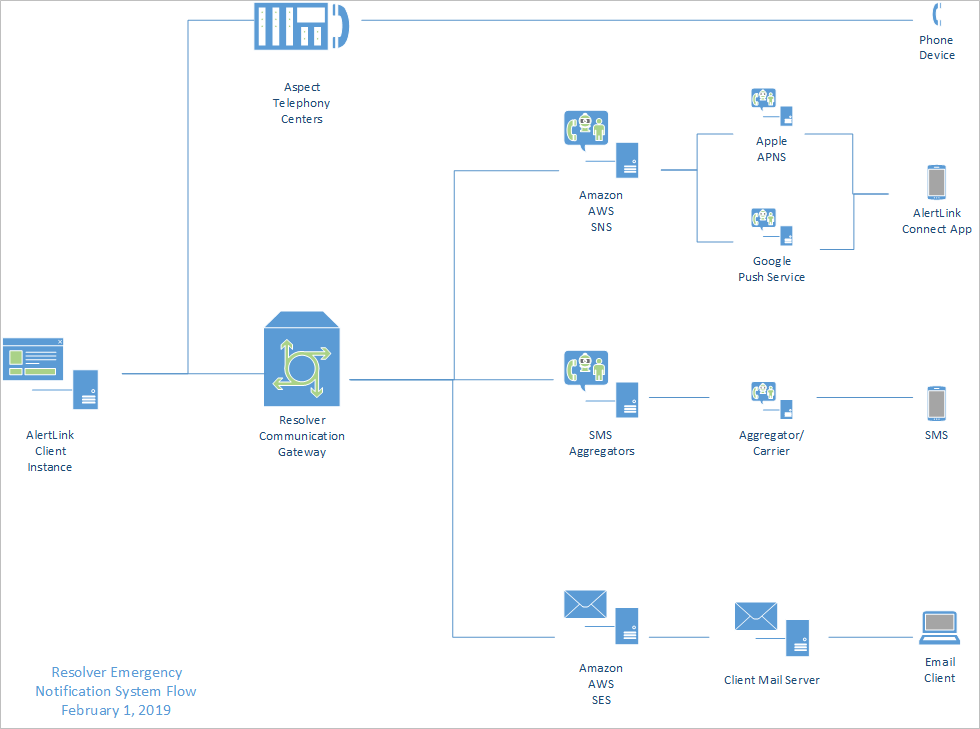Resolver’s emergency notification platform offers the ability to easily send thousands of messages through a variety of channels, including:
- Telephony;
- Email;
- SMS (text); and
- Push.
This document provides additional information about these channels, facts about our providers, and an overview of how responses are handled.
IMPORTANT NOTE: This document does not define service-level agreements or guaranteed delivery speeds. Refer to your contract or contact your CSM for more details.
 A diagram illustrating how messages flow through the channels.
A diagram illustrating how messages flow through the channels.
Telephony
Telephony messages are processed directly from your AlertLink instance to the telephony application, which is hosted with Aspect.
With data centers around the world that provide advanced availability, Aspect is a global leader in telephony communications, offering a 100% network uptime guarantee, connectivity to most countries and exchanges, and redundant voice systems with real-time automated failover.
Some other benefits of using Aspect include:
- n + k modular tiered architecture.
- Native high-performance SIP telephony.
- Pre-deployed redundant capacity.
- Redundant power.
- Geographic failover on components and call routing.
Our standard offering is a shared platform, with access to 200 shared telephony ports. This means that you can expect a maximum of 200 concurrent calls. As your calls disconnect, new calls are activated.
Example 1: 400 telephone numbers with a 30-second message length = 1 minute, plus processing time, to complete the job.
Example 2: 400 telephone numbers with a 1-minute message length = 2 minutes, plus processing time, to complete the job.
Telephone Message Responses
Once recipients select their response from the available options, those responses are posted back to our platform using web services and will appear in the interface within seconds of occurring.
All emails flow from your AlertLink instance to our Communication Gateway, where they’re processed based on a defined set of rules, before being routed through AWS’s Amazon Simple Email Service (Amazon SES). Though AWS doesn’t offer a guaranteed SLA, their email services are widely distributed and highly reliable.
Because email throughput varies based on factors such as message size, recipient email server capacity, spam filtering, etc., Resolver cannot provide specific metrics; however, our tests have shown consistent throughput of approximately 50 - 100 emails per second.
For information on improving email delivery, see our recommendations for whitelisting and email delivery optimization.
Email Message Responses
Recipients reply with the response indicated in the in the email. This response follows normal email processing, which travels from your client device, to your email server, then to Resolver’s email server. Once it arrives at our email server, it’s parsed to determine the details, then posted to our platform via web services. Due to the multiple steps in the standard email process, responses can be delayed in appearing in the interface by a few seconds to a few minutes.
SMS
All SMS traffic flows from your AlertLink instance to our Communications Gateway, where it’s routed and processed based on a specific set of rules that determine which aggregation service is used.
Our primary SMS aggregator is Infobip, which provides mobile delivery channels and connections to carriers around the globe. For specific country and carrier support, see our coverage list.
Some other benefits of our SMS providers include:
- 55+ offices worldwide.
- 190 countries covered.
- 9 private cloud locations.
- 7 R&D centers.
- 99.99% platform uptime.
- 400+ operator partnerships.
Note that SMS delivery varies by location. At this time, between 150 to 200 messages per second, not including processing time, can be expected in the United States and Canada. Similar speeds can be achieved in other countries; however, due to carrier variances, specific throughputs cannot be provided.
SMS Message Responses
Recipients reply with the response indicated in the in the SMS. Upon sending, the message will travel from your device to your carrier and from there can take several routes, depending upon your location and your carrier’s connections. Finally, the response is collected by our aggregator and the information is automatically posted via web services to our platform. Due to the multiple steps in the standard SMS process and several carrier network variables, responses can be delayed by a few seconds up to a few minutes before they appear in the interface.
Push
All push traffic flows from your AlertLink instance to our Communication Gateway, where it’s routed, processed, then sent to Amazon Simple Notification Service (SNS). Though AWS doesn’t offer a guaranteed SLA for SNS, their services are widely distributed and highly reliable.
Amazon SNS connects directly to Apple APNS (Apple Push Notification Service) and Firebase FCM (Firebase Cloud Messaging) and push notifications are not guaranteed by either Apple or Firebase. As such, Resolver cannot provide throughput guarantees for this service; however, Apple and Firebase limit the size of their push notifications, which results in excellent delivery speeds that are typically faster than other channels.
Push Message Responses
Push messages are delivered directly to the AlertLink Connect mobile application, where recipients choose their responses from the options shown in the app. Once submitted, the app communicates directly to our platform through web services. Responses then appear in the interface within seconds.


